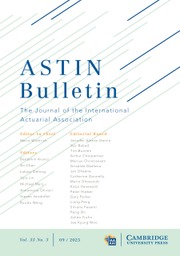No CrossRef data available.
Article contents
Multi-asset return risk measures
Published online by Cambridge University Press: 16 July 2025
Abstract
We revisit the recently introduced concept of return risk measures (RRMs) and extend it by incorporating risk management via multiple so-called eligible assets. The resulting new class of risk measures, termed multi-asset return risk measures (MARRMs), introduces a novel economic model for multiplicative risk sharing. We point out the connection between MARRMs and the well-known concept of multi-asset risk measures (MARMs). Then, we conduct a case study, based on an insurance dataset, in which we use typical continuous-time financial markets and different notions of acceptability of losses to compare RRMs, MARMs, and MARRMs and draw conclusions about the cost of risk mitigation. Moreover, we analyze theoretical properties of MARRMs. In particular, we prove that a positively homogeneous MARRM is quasi-convex if and only if it is convex, and we provide conditions to avoid inconsistent risk evaluations. Finally, the representation of MARRMs via MARMs is used to obtain various dual representations.
Keywords
Information
- Type
- Research Article
- Information
- ASTIN Bulletin: The Journal of the IAA , Volume 55 , Special Issue 3: Risk Sharing , September 2025 , pp. 668 - 694
- Copyright
- © The Author(s), 2025. Published by Cambridge University Press on behalf of The International Actuarial Association

